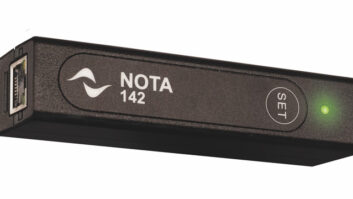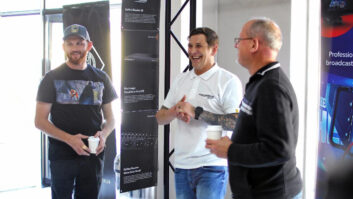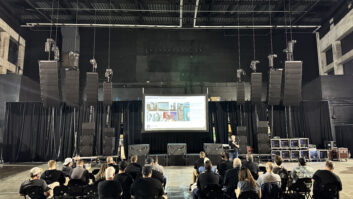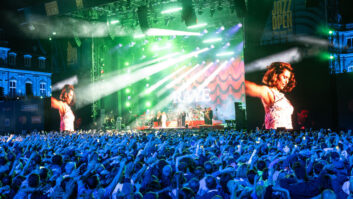It’s June and, with no fallow year until 2027, it’s time for the Glastonbury Festival of Contemporary Performing Arts. Over the 55 years since the first event in 1970, although there have been only 39 festivals due to regular breaks to allow the countryside to recover, plus Covid, the festival has grown in scale to become what the BBC described in publicity for its TV and radio coverage as a “giant tented city in Somerset”.
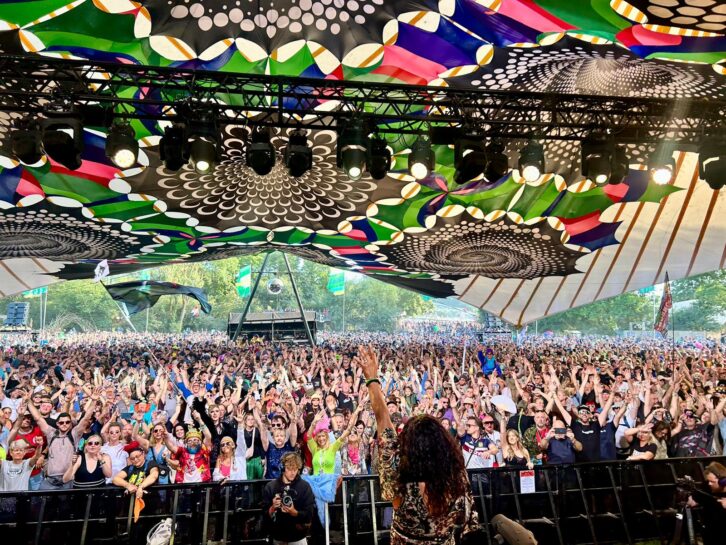
This comparison to a big metropolitan area works (it’s 1,000 acres), because Glastonbury comprises many different ‘towns’ – the various stages – that make up the whole but operate as individual entities with their own character, reflected in the performers they showcase and the audio technology they use.
MAIN STAGE
The city centre is the Pyramid Stage, hosting many of the big names on the bill. This year these include The 1975, Neil Young, Burning Spear, Alanis Morrissette, Olivia Rodrigo and Rod Stewart. Many of these and others, on both the Pyramid and other stages, are bringing their own mixing consoles, line systems and monitoring gear.
Ben Milton, head of sound for the Pyramid Stage, says: “The audio design remit is that we have the capacity to facilitate the sound for every act who performs on the Pyramid Stage as a headliner, so they can turn up with no equipment [although they bring their own instruments] and we can still put on a Grade A show for them. The requirements for this year span from us providing everything, including engineers, to the act providing everything, with all different permutations in between.”
The front-of-house (FOH) loudspeakers for the Pyramid are based on Martin Audio’s MLA range, with four hangs for the main left and right with one MLD, a central cardioid sub-bass array of 32 MLX subs and two DD12 fills. There will also be near-field, far-field and back-of-field delays in addition to the in-fills and FOH fills, all of which will also be Martin cabinets.
For the front-end of the PA drive system, Milton is using DirectOut PRODIGY.MP multi-function audio processors. “All house and visiting consoles will be inputted to these, which will additionally derive outputs to the PA,” he explains. “Timing and EQ of the rig will also be done within the PRODIGY.MPs. The computer running these units will be accessible via people’s laptops or tablets over a site-wide wireless network, which enables us to work on the system EQ, timing and other parameters from anywhere within the Pyramid arena.”
The house FOH consoles for Pyramid will be two DiGiCo SD12-96s with an SD rack, while the monitors are to be mixed on two DiGiCo Q326s. There is also a Q852 as the ‘media console’, which will be used for the house DJ, video inputs and any spoken word links between acts, as well as an opening show on Wednesday night (25 June) plus producing a multitrack recording for the BBC.
Hire company RG Jones Sound Engineering is supplying the Pyramid system, together with those for another of the main stages, West Holts (focused primarily on hip hop, soul and reggae) and two venues in the Block9 late-night enclosure, IICON and Genosys. The last three are Martin Audio Wavefront Precision rigs, which, explains Jack Bowcher, project manager for RG Jones, were specified to “meet the distinct sonic and structural requirements of those environments”.

ALTERNATIVE SOUNDS
The ‘second town’ of Glastonbury is The Other Stage. Originally known as a showcase for ‘alternative’ acts, this year it hosts a line-up including Franz Ferdinand, Wet Leg, Charli XCX, Wolf Alice, Nadine Shah and Snow Patrol.
The sound system, supplied by Entec Live, centres on d&b audiotechnik loudspeakers, with the main rig comprising 36 GSLs for the main hangs (18 a side), 32 GSLs as side hangs (16 per side), 24 V-Series cabinets for the out-hangs (12 a side), eight V-Series for the centre cluster, 22 SL-SUB LF boxes on the ground, 16 SL- SUBs flown eight per side, eight Y10Ps and two V7Ps as front fills, with everything powered by d&b D80 amps. FOH mixing is on two DiGiCo SD10 consoles, with a small format desk for the changeovers, supported by two SD racks (56-in, 40-out, 16-AES). Monitor desks are two SD12-96s, again with two SD racks.
A major part of Glastonbury over the years has been showcasing new artists, which are presented on a dedicated stage, Woodsies (until 2023 the John Peel Stage and before that the New Bands Tent). Over each of these incarnations sound systems have been supplied by SWG Events, which also works on Left Field and the Park and BBC Introducing stages. SWG’s head of audio, Simon Purse, comments that with bigger systems, as for Woodsies, “a lot of directivity control” is required to reduce off-site noise and get the best coverage across the audience.
“We use a lot of Martin’s proprietary system to optimise the PA in the Woodsies tent,” Purse says. “We also have Outline Newton racks to manage the PA systems for Woodsies and Park Stage before the signal gets to the Martin software and deal with incoming signals from gear brought in by artists who are on tour.”
The main rig for Woodsies will be a Martin WPL, with 12 cabinets a side in two-box resolution plus 12 SXH218 subs in bridged mode and eight WPC front fills. Park Stage has a Martin W8LC system featuring an updated control set-up based on new DX4.0 DSPs. “This allows us to control the system over a network in the same way we would EQ and time align the new systems,” Purse explains. Left Field features six WPS boxes per side, SX218 subs and Blackline X12 front fills, while the BBC Introducing stage has four WPCs, six SX218s and X12 front fills. Consoles on Woodsies and Park are DiGiCo, with Allen & Heath and/or Yamaha desks for Left Field and BBC Introducing.
BIG IMPACT
One of the biggest impacts made at Glastonbury 2024 was the mechanical Dragonfly, built from an old Royal Navy helicopter with insect additions, lasers and mappable lighting effects. It returns to the Arcardia Spectacular stage this year, where it will be augmented by 360-degree lighting distributed across ten towers and a six-point immersive sound system based on L-Acoustics L and K Series loudspeakers. The audio component, supplied by AF Live, was designed by Bryan Mclean, director of Dirt Sound, who says supplementary towers and out-fills have been added over the years to maintain consistent coverage as the audiences for Arcadia have grown.
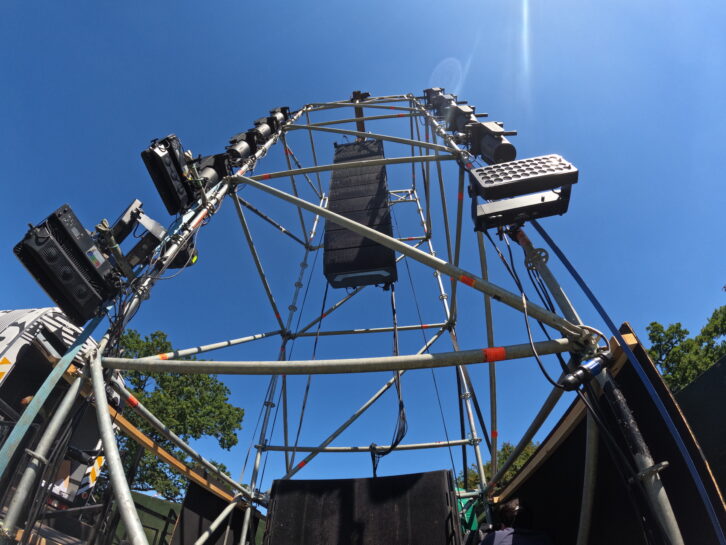
The main rig will consist of six towers, each with one L2, one L2D and four KS28 subs, while an inner four-point system of KS21s and KARA boxes will maintain SPL over the central soundfield. In addition, there are to be “multiple” KARA II tower fills and four L2 out-fills, plus what Mclean describes as “a little something special” under the body of Dragonfly for “some crazy bass energy.”
More extreme low-end audio can be found on the Glade Stage, which will feature a block of Funktion-One’s F124s for the bass frequencies and a column of what are described as “improved” F132 subs. “We’ve sorted out the resonance and given it more control,” explains Funktion-One founder and director of R&D Tony Andrews, who has been involved with sound at Glastonbury since its early days and uses the Festival as a development lab for new systems.
The overall system for The Glade, which hosts both live bands and DJ sets, is the Vero VX, provided by rental firm Audio Plus. The FOH system will comprise seven VX90s on each side and four VX90s per side as out-fills and five VX90s a side for delays, while the main bass stack is to have 18 F124s in a cardioid configuration, four F132 subs together near the main hang PA, four F124s as bass fills and three F124s a side as bass delays. FOH consoles will be two SSL Live L550 Plus desks, with a Yamaha DM3 for announcements, change overs and auxiliary playback.
The Glade epitomises the dance element of Glastonbury, as does The Common with its rave background. This field is made up of The Temple, the Rum Shack, Mez Yard, Kinetic and Temple Uprising, with Manchester hire company Neuron AV supplying sound systems for each. All these feature Danley Sound Labs point source rigs, which Jonny Wharton, director of event production for Neuron, explains continue the “cultural identity” of the 80s and 90s rave scene.
DANCE TEMPLE
The Temple will include a four-point in-the-round system of four Danley Jericho J3-94s, which, as Wharton says, are among the larger boxes in the manufacturer’s Synergy Horn range. There will also be SH96HOs on the ground as large-format front fills with the smaller SH95HO for balcony fills. The DJ booth will include a Dante-controlled Allen & Heath SQ-7 console, which will run in a “back-of-house” position. “This means the engineers are closer to the artists and DJs,” comments Wharton. “We will also have remote iPad control over the desk.”

The entire audio production at Glastonbury relies heavily on wireless technology, particularly with radio mics and IEMs. As well as Shure and Wisycom, Sennheiser will be playing a major role, including on the Arcadia stage. The Spectera WMAS (Wireless Multichannel Audio Systems) and Evolution EW-DX digital system will feature on the Dragonfly, with the former part of the house IEM set-up. Spectera will also be used by Nile Rodgers and Chic, and Dhani Harrison, with Digital 6000 specified for other areas of the site.
Media regulator Ofcom is coordinating and licensing all radio frequencies used during the Festival. More than 2000 were licensed for last year’s event, including, for the first time, those in the DME (Distance Measuring Equipment) band. Further flexibility has been offered this time by using WMAS technology, which is making its Glasto debut.
This all makes for a broad mix of technologies, old and new, for an eclectic Glastonbury programme of artists and styles, both old and new.
Glastonbury Festival 2025 takes place at Worthy Farm, Somerset, England from Wednesday June 25 to Sunday June 29, with the main bills playing from Friday June 27.


